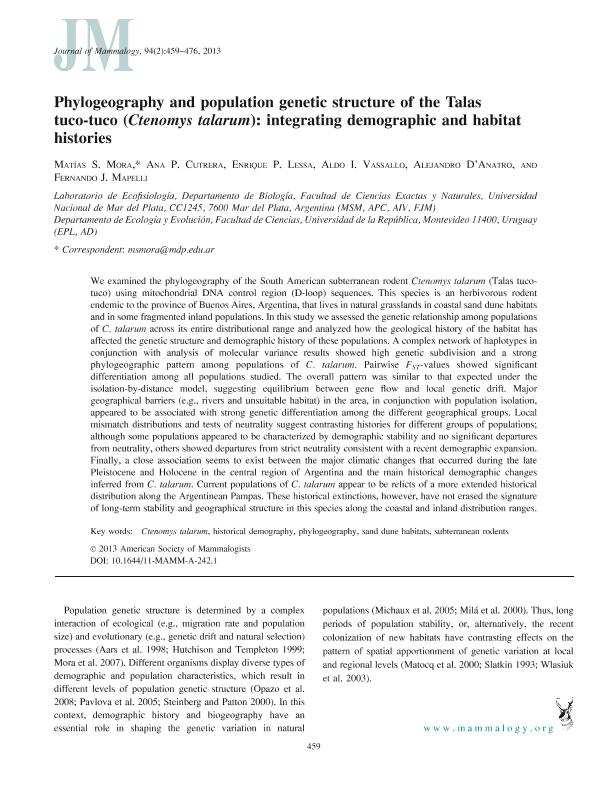Mostrar el registro sencillo del ítem
dc.contributor.author
Mora, Matias Sebastian

dc.contributor.author
Cutrera, Ana Paula

dc.contributor.author
Lessa, Enrique P.

dc.contributor.author
Vassallo, Aldo Iván

dc.contributor.author
D´Anatro, Alejandro
dc.contributor.author
Mapelli, Fernando Javier

dc.date.available
2017-10-05T19:29:19Z
dc.date.issued
2013-06
dc.identifier.citation
Mora, Matias Sebastian; Cutrera, Ana Paula; Lessa, Enrique P.; Vassallo, Aldo Iván; D´Anatro, Alejandro; et al.; Phylogeography and population genetic structure of the Talas tuco-tuco (Ctenomys talarum): integrating demographic and habitat histories; Alliance Communications Group Division Allen Press; Journal of Mammalogy; 94; 2; 6-2013; 459-476
dc.identifier.issn
0022-2372
dc.identifier.uri
http://hdl.handle.net/11336/26025
dc.description.abstract
We examined the phylogeography of the South American subterranean rodent Ctenomys talarum (Talas tuco-tuco) using mitochondrial DNA control region (D-loop) sequences. This species is an herbivorous rodent endemic to the province of Buenos Aires, Argentina, that lives in natural grasslands in coastal sand dune habitats and in some fragmented inland populations. In this study we assessed the genetic relationship among populations of C. talarum across its entire distributional range and analyzed how the geological history of the habitat has affected the genetic structure and demographic history of these populations. A complex network of haplotypes in conjunction with analysis of molecular variance results showed high genetic subdivision and a strong phylogeographic pattern among populations of C. talarum. Pairwise FST-values showed significant differentiation among all populations studied. The overall pattern was similar to that expected under the isolation-by-distance model, suggesting equilibrium between gene flow and local genetic drift. Major geographical barriers (e.g., rivers and unsuitable habitat) in the area, in conjunction with population isolation, appeared to be associated with strong genetic differentiation among the different geographical groups. Local mismatch distributions and tests of neutrality suggest contrasting histories for different groups of populations; although some populations appeared to be characterized by demographic stability and no significant departures from neutrality, others showed departures from strict neutrality consistent with a recent demographic expansion. Finally, a close association seems to exist between the major climatic changes that occurred during the late Pleistocene and Holocene in the central region of Argentina and the main historical demographic changes inferred from C. talarum. Current populations of C. talarum appear to be relicts of a more extended historical distribution along the Argentinean Pampas. These historical extinctions, however, have not erased the signature of long-term stability and geographical structure in this species along the coastal and inland distribution ranges.
dc.description.abstract
A partir del uso de secuencias de ADN mitocondrial de la región control (D-loop), analizamos la filogeografía del roedor sudamericano Ctenomys talarum (tuco-tuco de los talares). Esta especie es un roedor herbívoro y endémico de la Provincia de Buenos Aires, Argentina, que habita pastizales naturales en dunas costeras y en algunas poblaciones continentales fragmentadas. En este estudio evaluamos las relaciones genéticas entre las poblaciones de C. talarum a través de su rango de distribución total y analizamos cómo la historia geológica de su hábitat ha afectado la estructura genética y la demografía histórica de estas poblaciones. Tanto la red de haplotipos como los análisis de la varianza molecular mostraron alta subdivisión genética y un patrón filogeográfico profundo entre las poblaciones de C. talarum. Los valores de FST pareados mostraron una diferenciación significativa entre todas las poblaciones estudiadas. El patrón general fue similar al esperado bajo un modelo de aislamiento por distancia, evidenciando un equilibrio entre flujo génico y deriva genética local. Las barreras más importantes en el área (e.g. ríos y hábitat poco apto para la ocupación) y el propio aislamiento poblacional se asociarían con una fuerte diferenciación genética entre los diferentes grupos geográficos. Las diferencias pareadas entre sitios nucleotídicos y los tests de neutralidad sugieren historias contrastantes para los diferentes grupos de poblaciones; mientras algunas de ellas se caracterizaron por presentar estabilidad demográfica, otras mostraron apartamientos de la neutralidad estricta, consistente con una expansión demográfica reciente. Finalmente, los cambios climáticos más importantes ocurridos durante el Pleistoceno Tardío y Holoceno en la región central de Argentina parecen estar asociados a los principales cambios demográficos históricos inferidos para C. talarum. Las poblaciones actuales de C. talarum parecen ser relictos de una distribución histórica más extendida a lo largo de la pampa Argentina. Dichas extinciones históricas, sin embargo, no han borrado la señal de estabilidad a largo término y la estructura geográfica de esta especie en los rangos de distribución costeros y continentales.
dc.format
application/pdf
dc.language.iso
eng
dc.publisher
Alliance Communications Group Division Allen Press

dc.rights
info:eu-repo/semantics/openAccess
dc.rights.uri
https://creativecommons.org/licenses/by-nc-sa/2.5/ar/
dc.subject
Ctenomys Talarum
dc.subject
Historical Demography
dc.subject
Phylogeography
dc.subject
Sand Dune Habitats
dc.subject
Subterranean Rodents
dc.subject.classification
Bioquímica y Biología Molecular

dc.subject.classification
Ciencias Biológicas

dc.subject.classification
CIENCIAS NATURALES Y EXACTAS

dc.title
Phylogeography and population genetic structure of the Talas tuco-tuco (Ctenomys talarum): integrating demographic and habitat histories
dc.type
info:eu-repo/semantics/article
dc.type
info:ar-repo/semantics/artículo
dc.type
info:eu-repo/semantics/publishedVersion
dc.date.updated
2017-10-03T17:33:55Z
dc.journal.volume
94
dc.journal.number
2
dc.journal.pagination
459-476
dc.journal.pais
Estados Unidos

dc.journal.ciudad
Lawrence
dc.description.fil
Fil: Mora, Matias Sebastian. Universidad Nacional de Mar del Plata. Facultad de Ciencias Exactas y Naturales. Departamento de Biología; Argentina
dc.description.fil
Fil: Cutrera, Ana Paula. Universidad Nacional de Mar del Plata. Facultad de Ciencias Exactas y Naturales. Departamento de Biología; Argentina
dc.description.fil
Fil: Lessa, Enrique P.. Universidad de la República; Uruguay
dc.description.fil
Fil: Vassallo, Aldo Iván. Universidad Nacional de Mar del Plata. Facultad de Ciencias Exactas y Naturales. Departamento de Biología; Argentina
dc.description.fil
Fil: D´Anatro, Alejandro. Universidad de la República; Uruguay
dc.description.fil
Fil: Mapelli, Fernando Javier. Universidad Nacional de Mar del Plata. Facultad de Ciencias Exactas y Naturales. Departamento de Biología; Argentina
dc.journal.title
Journal of Mammalogy

dc.relation.alternativeid
info:eu-repo/semantics/altIdentifier/doi/http://dx.doi.org/10.1644/11-MAMM-A-242.1
dc.relation.alternativeid
info:eu-repo/semantics/altIdentifier/url/http://www.bioone.org/doi/abs/10.1644/11-MAMM-A-242.1
Archivos asociados
